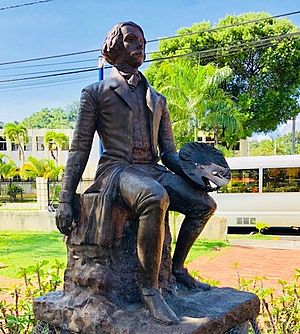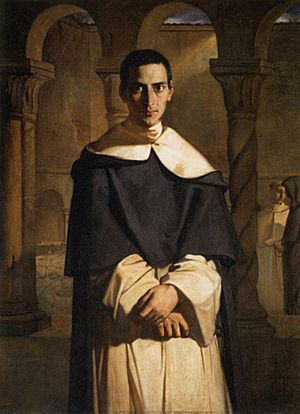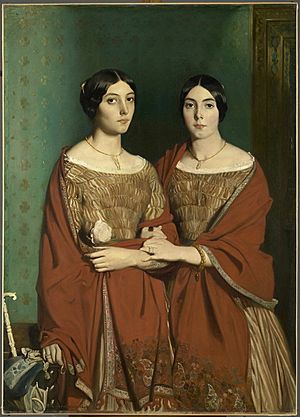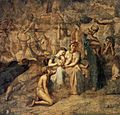Théodore Chassériau facts for kids
Quick facts for kids
Théodore Chassériau
|
|
|---|---|

A self-portrait of Chassériau painted at the age of 16
|
|
| Born | September 20, 1819 |
| Died | October 8, 1856 (aged 37) |
| Nationality | French |
| Education | Jean-Auguste-Dominique Ingres |
| Movement | Romanticism; Orientalism |
Théodore Chassériau (born September 20, 1819 – died October 8, 1856) was a French painter. He was born in what is now the Dominican Republic. He is famous for his portraits and paintings of history and religion. He also created art inspired by his travels to Algeria, called Orientalist art.
At first, he painted in a style called Neoclassicism, like his teacher Jean-Auguste-Dominique Ingres. Later, he was inspired by the Romantic style of Eugène Delacroix. Chassériau was also a talented draftsman. He made a series of prints to illustrate Shakespeare's play Othello. When he was just 15 years old, he painted a portrait of Prosper Marilhat. This painting made Théodore Chassériau the youngest artist to have a work shown at the famous Louvre Museum.
Contents
Life and Art Journey
Théodore Chassériau was born in El Limón, Samaná. This area was part of the Spanish colony of Santo Domingo. Today, it is the Dominican Republic. His father, Benoît Chassériau, was a French adventurer. His mother, Maria Magdalena Couret de la Blagniére, was from Saint-Domingue (now Haiti).
In December 1820, his family moved to Paris, France. Young Chassériau quickly showed a great talent for drawing. When he was only eleven, in 1830, he joined the studio of Jean-Auguste-Dominique Ingres. Ingres was a famous classicist painter. He saw Chassériau as his best student. Some say Ingres even called him "the Napoleon of painting."

In 1834, Ingres left Paris to lead the French Academy in Rome. After this, Chassériau became interested in the art of Eugène Delacroix. Delacroix used bold colors in his paintings, which was very different from Ingres's style. Many people say Chassériau's art tried to mix Ingres's classic style with Delacroix's romantic style.
Chassériau first showed his art at the Paris Salon in 1836. He won a third-place medal for his history painting. In 1840, Chassériau went to Rome. He met Ingres there, but Ingres was unhappy with the new direction of his student's art. This meeting caused a final break between them. While in Italy, Chassériau sketched landscapes and studied old fresco paintings.


Some of his important early works include Susanna and the Elders and Venus Anadyomene (both from 1839). Other famous paintings are Diana Surprised by Actaeon (1840) and The Toilette of Esther (1841). His religious paintings, like Christ on the Mount of Olives (1840 and 1844) and The Descent from the Cross (1842), got mixed reviews. However, the writer Théophile Gautier was one of his supporters.
In 1843, Chassériau painted murals for the Church of Saint-Merri in Paris. These murals showed the life of Saint Mary of Egypt. This was the first of many projects he received to decorate public buildings in Paris.
His portraits from this time include the Portrait of the Reverend Father Dominique Lacordaire (1840). He also painted The Two Sisters (1843). This painting shows his own sisters, Adèle and Aline.
Chassériau was a very active draftsman throughout his life. His many portrait drawings, made with a sharp pencil, look similar to Ingres's style. He also made 29 prints. This included 18 etchings based on scenes from Shakespeare's Othello in 1844.
In 1845, he showed a huge portrait called Ali-Ben-Hamet, Caliph of Constantine and Chief of the Haractas, Followed by his Escort. It received mixed opinions at the Salon. In 1846, Chassériau visited Algeria for the first time. From his sketches there, he painted works like Arab Chiefs Visiting Their Vassals and Jewish Women on a Balcony (both 1849, now at the Louvre).
A major later work is The Tepidarium (1853, in the Musée d'Orsay). It shows many women drying themselves after bathing. The setting was inspired by his trip to Pompeii in 1840. His biggest project was decorating the grand staircase of the Cour des Comptes. The state asked him to do this in 1844, and he finished it in 1848. He used oil paint on plaster, like Delacroix. Sadly, this work was badly damaged by a fire in May 1871 during the Paris Commune. Only parts of it could be saved, and they are now in the Louvre.
After a period of poor health, made worse by his hard work on church murals, Chassériau died in Paris. He was only 37 years old. He passed away on October 8, 1856, and is buried in the Montmartre Cemetery.
His Lasting Influence
Théodore Chassériau's art had a big impact on other painters. These included Puvis de Chavannes and Gustave Moreau. Through their work, his influence also reached artists like Paul Gauguin and Henri Matisse. There is even a group in Paris called the Association des Amis de Théodore Chassériau. This group is dedicated to his memory.
You can see Chassériau's works in many museums. The Musée du Louvre in Paris has a room just for him. His art is also at the Musée d'Orsay and the Musée de Versailles. In the United States, his paintings are in places like the Metropolitan Museum of Art in New York. You can also find them at the Harvard Art Museums, the National Gallery of Art in Washington, D.C., and The J. Paul Getty Museum.
Art Exhibitions
Chassériau's art has been shown in many exhibitions around the world:
- Théodore Chassériau: Parfum exotique, National Museum of Western Art of Tokyo, Japan, 2017
- Théodore Chassériau: Obras sobre papel, Galerie nationale des beaux-arts de Santo Domingo and Centro cultural León de Santiago de los Caballeros, Dominican Republic, 2004
- Théodore Chassériau (1819–1856): A Different Romanticism, Metropolitan Museum of Art, New York (United States), Galeries nationales du Grand Palais in Paris (France) and Musée des beaux-arts de Strasbourg (France), 2002
- Restrospective Théodore Chassériau (1819–1856), Musée de l'Orangerie, Paris, France, 1933
Selected Works
Here are some of Théodore Chassériau's well-known paintings:
- Self-portrait - Musée du Louvre
- Aline Chassériau - Musée du Louvre
- Battle of Arab Horsemen Around a Standard (1854) - Dallas Museum of Art
- The Caliph of Constantine
- Andromeda Chained to the Rock by the Nereids
- Arab Chiefs Visiting their Vassals
- Christ on the Mount of Olives
- The Descent from the Cross
- Diana Surprised by Actaeon
- Jewish Women on a Balcony
- Othello and Desdemona in Venice
- Susanna and the Elders
- Venus Anadyomene
- The Tepidarium
- The Toilette of Esther
- The Two Sisters
Images for kids
-
Portrait de la comtesse de La Tour Maubourg, 1841, Metropolitan Museum of Art, New York
-
Scene in the Jewish Quarter of Constantine, 1851, Metropolitan Museum of Art, New York
-
Portrait d'Alphonse de Lamartine, 1844
See also
 In Spanish: Teodoro Chassériau para niños
In Spanish: Teodoro Chassériau para niños
- Léonce Bénédite
- List of Orientalist artists
- Orientalism









